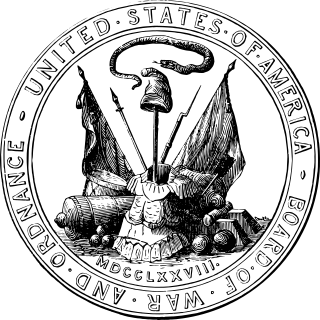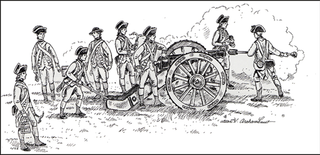
The Continental Army was the army of the United Colonies representing the Thirteen Colonies and later the United States during the American Revolutionary War. It was formed on June 14, 1775 by a resolution passed by the Second Continental Congress, meeting in Philadelphia after the war's outbreak. The Continental Army was created to coordinate military efforts of the colonies in the war against the British, who sought to maintain control over the American colonies. General George Washington was appointed commander-in-chief of the Continental Army and maintained this position throughout the war.

The Battle of Camden, also known as the Battle of Camden Court House, was a major victory for the British in the Southern theater of the American Revolutionary War. On August 16, 1780, British forces under Lieutenant General Charles, Lord Cornwallis routed the numerically superior American forces led by Major General Horatio Gates about four miles north of Camden, South Carolina, thus strengthening the British hold on the Carolinas following the capture of Charleston.

The 1st Continental Light Dragoons, also known as Bland's Horse, was a mounted regiment of the Continental Army organized between 13 June and 10 September 1776 in Williamsburg, Virginia. It was made up of men from eastern and northern Virginia for service with the Continental Army.

The 1st Virginia Regiment was an infantry regiment of the Virginia Line that served with the Continental Army during the American Revolutionary War.
The 2d Virginia Regiment was authorized by the Virginia Convention, July 17, 1775, as a force of regular troops for the Commonwealth's defense. It consisted of seven companies, 476 privates and the usual regimental officers. William Woodford, of Caroline County, named colonel, along with Lieutenant Colonel Charles Scott and Major Alexander Spotswood were the regiment's initial field officers. Virginia had been divided into 16 military districts which took their names from the predominant county in the grouping; for instance, Prince William District included Fairfax and Loudoun Counties as well. Col. Gregory Smith 1777-78 Col Brent 1779
The 5th Virginia Regiment was raised on December 28, 1775, at Richmond, Virginia, for service with the U.S. Continental Army. The regiment saw action at the Battle of Trenton, Battle of Princeton, Battle of Brandywine, Battle of Germantown, Battle of Monmouth and the Siege of Charleston. The regiment was joined to the 3rd Virginia Regiment on May 12, 1779. General William Russell and Col. Josiah Parker were two of its commanders.
The 6th Virginia Regiment was raised on December 28, 1775, at Williamsburg, Virginia, for service with the Continental Army. The regiment would see action at the Battle of Trenton, Battle of Princeton, Battle of Brandywine, Battle of Germantown, Battle of Monmouth and the Siege of Charleston. The regiment was merged into the 2nd Virginia Regiment on May 12, 1779.
The 10th Virginia Regiment was raised on December 28, 1775, in western Virginia for service with the Continental Army. The regiment would see action at the Battle of Brandywine, Battle of Germantown, Battle of Monmouth and the Siege of Charleston. Most of the regiment was captured at Charlestown, South Carolina, on May 12, 1780, by the British and the regiment was formally disbanded on November 15, 1783.
The 11th Virginia Regiment was a Continental Army regiment that fought in the American Revolutionary War.
The 13th Virginia Regiment was a United States infantry regiment during the American Revolutionary War.
The 14th Virginia Regiment was raised on September 16, 1776, in western Virginia for service with the Continental Army. The regiment would see action at the Battle of Brandywine, Battle of Germantown, Battle of Monmouth, and Siege of Charleston. Most of the regiment was captured at Charlestown, South Carolina, on May 12, 1780, by the British Army. The regiment was formally disbanded on November 15, 1783.

The "Maryland Line" was a formation within the Continental Army, formed and authorized by the Second Continental Congress, meeting in the "Old Pennsylvania State House" in Philadelphia, Pennsylvania in June 1775.

The Massachusetts Line was those units within the Continental Army that were assigned to Massachusetts at various times by the Continental Congress during the American Revolutionary War. These, together with similar contingents from the other twelve states, formed the Continental Line. Line regiments were assigned to a particular state, which was then financially responsible for the maintenance of the regiment. The concept of the line was also particularly important in relation to the promotion of commissioned officers. Officers of the Continental Army below the rank of brigadier general were ordinarily ineligible for promotion except in the line of their own state.

The New Hampshire Line was a formation in the Continental Army. The term "New Hampshire Line" referred to the quota of numbered infantry regiments assigned to New Hampshire at various times by the Continental Congress. These, along with similar contingents from the other twelve states, formed the Continental Line. For the promotion of senior officials, this concept is particularly important. Officers of the Continental Army below the rank of brigadier general were ordinarily ineligible for promotion except in the line of their own state.

The Virginia Line was a formation within the Continental Army. The term "Virginia Line" referred to the quota of numbered infantry regiments assigned to Virginia at various times by the Continental Congress. These, together with similar contingents from the other twelve states, formed the Continental Line. The concept was particularly important in relation to the promotion of commissioned officers. Officers of the Continental Army below the rank of brigadier general were ordinarily ineligible for promotion except in the line of their own state.

The Maryland and Virginia Rifle Regiment, most commonly known as Rawlings' Regiment in period documents, was organized in June 1776 as a specialized light infantry unit of riflemen in the Continental Army during the American Revolutionary War. The American rifle units complemented the predominant, musket-equipped, line infantry forces of the war with their long-range marksmanship capability and were typically deployed with the line infantry as forward skirmishers and flanking elements. Scouting, escort, and outpost duties were also routine. The rifle units' battle formation was not nearly as structured as that of the line infantry units, which employed short-range massed firing in ordered linear formations. The riflemen could therefore respond with more adaptability to changing battle conditions.

The 1st Continental Artillery Regiment, also known as Harrison's Continental Artillery Regiment, was authorized on 26 November 1776 as Colonel Charles Harrison's Continental Artillery Regiment. Raised for service during the American Revolutionary War, as originally organized, the regiment comprised 10 artillery companies from Virginia. Two of the artillery companies existed since early 1776. The regiment was first assigned to the Southern Department, but in March 1778 it was reassigned to General George Washington's main army. In August 1779, the unit was renamed the 1st Continental Artillery Regiment. It continued to serve with the main army until April 1780 when it was transferred to the Southern Department. In May 1780, Maryland artillery companies formally joined the regiment, making a total of 12 companies. In January 1781, the regiment was reorganized with 10 companies. Furloughed in the summer of 1783, the regiment was disbanded in November the same year. Elements of the regiment fought at Monmouth, Charleston, Camden, Hobkirk's Hill, Eutaw Springs, Yorktown, and Combahee River.
The 1st Virginia State Regiment was a regiment of regular state troops from Virginia which fought during the American Revolutionary War.






